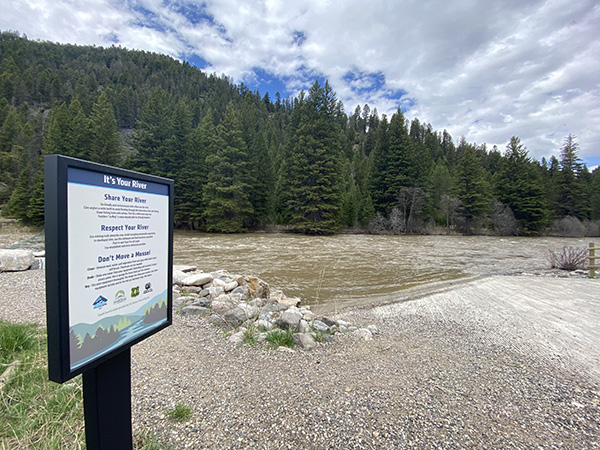We all know that the Gallatin River has so much to offer. On top of its breathtaking beauty and critical habitat, our watershed is known for its world-class fly-fishing, rafting, and abundant access to scenic hikes through the Custer-Gallatin National Forest. Unfortunately, all this human activity also inevitably leads to degradation of these areas. Over time, our favorite activities cause soil compaction and streambank erosion, which leads to habitat loss and lower water quality. In part, this is due to the river’s easy access off of Highway 191. While there are pullouts, many folks like to get closer to the river, creating their own points of access by driving off road into more delicate areas along the streambank. It only takes one person pulling off the highway to encourage others to investigate what could be a winning fishing spot, easy boat launch, or walking trail.
It is important to understand how vehicle and foot traffic damage the riparian buffer. A riparian buffer is the area of vegetation along the streambank that protects the river. When cars or people trample vegetation along the streambed, it compacts the soil and makes it harder for new plants to grow. Riparian buffers are important for the river and fish / wildlife habitat for several reasons. One, the roots stabilize the soil and prevent sediment loading into the river – too much sedimentation makes it harder for fish to access oxygen and degrades the water quality. Two, the roots actually work as a filter, taking in nutrients that contribute to nuisance algae blooms. Additionally, the tops of the vegetation grow up and up, providing shade to the river that helps keep water temperatures low – and more suitable for fish in the hot summer months.
Luckily, recreating responsibly is possible. To help find this balance, we are working with the Custer-Gallatin National Forest to restore degraded areas and provide access points so that we can enjoy the river all summer long. The Gallatin River Restoration Strategy was created to help identify over 100 areas along the Gallatin that are in need of some restorative love. Completed projects include Moose Creek and Deer Creek where we added parking lots, boat launches, fishing platforms, and planted hundreds of trees and shrubs to restore the riparian buffer. This created appropriate places for folks to pull into a safe place to fish or have boat access, while not treading on the important vegetation protecting the river. Other identified sites you may be familiar with include: Porcupine/Beaver Creek, Portal Creek, Lava Lake, and Storm Castle. These projects will help us continue to do the things we love, while making the Gallatin River happy and healthy.
To learn more about our projects, what we have coming up, and how you can help – visit the restoration page on our website. Other ways that you can responsibly recreate around the Gallatin River (or anywhere else you travel!) include: staying on designated trails, cleaning boots, boats, and other gear to prevent the spread of invasive species, and pack out all of your trash and food waste.
We’re looking forward to a jam-packed summer of fishing, rafting, and more. We hope to see you on the river!

